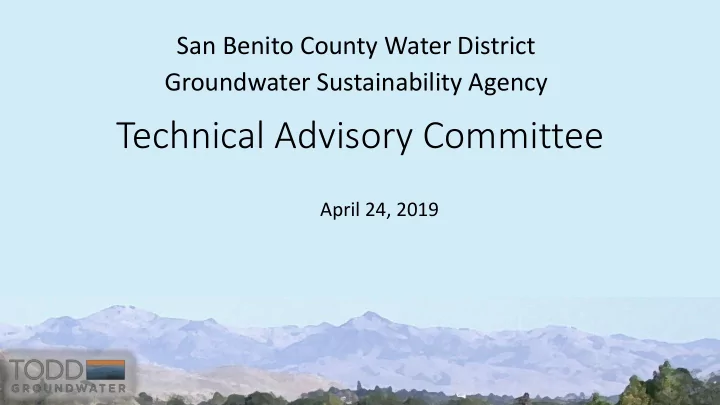

San Benito County Water District Groundwater Sustainability Agency Technical Advisory Committee April 24, 2019
Overview of Agenda • Follow-up on last meeting • Schedule • HCM and GW Conditions sections • Management areas and sustainability criteria • Update on outreach • TAC next steps
Highlights Hydrogeologic Conceptual Model (HCM) Groundwater Conditions
Cross section orientations
A long, irregular but continuous basin
Aquifer materials • Aquifers are lenses of coarse grained (gravel and sand) and fine grained (silt and clay) materials • No clear distinction into major identifiable units • Aquifers extend to variable, poorly- known depths beyond the bottom of most wells.
Current recharge occurs over the entire Basin
Groundwater elevation contours
Representative long term hydrograph 11-5-35G1
Basin-wide vertical displacement estimates from satellite measurements
Historical ground surface elevation from GPS monitoring
Groundwater quality: TDS • Mineralized and marginal in part reflecting local geology
Groundwater quality: nitrate
Surface water is locally connected to groundwater • First phase of surface water GW evaluation • Combined review of depth to water, local knowledge, conceptual model, and mapped features • Locations will be further evaluated relating to sustainability indicators
Where are we now in GSP process? HCM establishes physical framework of the groundwater basin GW Conditions Section documents historical and current status • Water Budget will quantify inflows, outflows and storage change • Numerical Model will support understanding of how the groundwater system works and provide the key analytical tool to evaluate: • Sustainability criteria • Monitoring • Projects and management actions
Ten-minute break Follow-up on last meeting Schedule HCM and GW Conditions Section • Management areas and sustainability criteria • Groundwater levels • Subsidence • Update on outreach • TAC next steps
Management Areas What are they? Areas for which GSP may identify different minimum thresholds, measurable objectives, monitoring, projects, management actions How defined? Different water uses, water sources, geology, aquifer characteristics, etc. Why have them? To facilitate implementation of the GSP
Why divide the basin? How were MAs defined?
Management Areas Upcoming TM will describe • Basin setting (hydrogeology, water budget, etc.) • Reasons for each management area GSP sustainability chapter also will document • Monitoring sites and program as appropriate • Minimum thresholds and measurable objectives • How management areas can operate together
Sustainability criteria: groundwater levels Recap: What are potential undesirable results? Water Table • loss of yield in wells Operable • impacts on flow to other areas Range of How do we identify undesirable results? Water Pump setting • historical lows Top of screen Levels • shallow well construction How do we identify key wells? Total well depth
Wells with representative hydrographs Relatively long, complete, reliable record Recently monitored Geographically distributed
Next steps with groundwater levels • Currently reviewing recent domestic well construction • Top of screens • Total well depth • Relating domestic well characteristics to potential key wells • Identifying preliminary thresholds and undesirable results (how long, how often, rate of decline)
Sustainability criteria: subsidence Do we have enough data • to evaluate factors affecting subsidence? • to establish a minimum threshold? • to conduct a monitoring program? • to define responsive management actions?
What are the potential undesirable results? • Well casings protruding from the ground • Well casing collapse • Un-leveling of agricultural fields • Reduced (or even reversed!) flow in ditches, canals, and drains • Damage to structures
How to establish criteria? Minimum Threshold is a rate and extent of subsidence • Consider potential undesirable results: wells, drainage channels, floodways, transportation facilities • Evaluate sustainability criteria commensurate with understanding of the basin setting, uncertainty, and data gaps • Gather more subsidence data (InSAR? UNAVCO? Other?) over next 5 years? • Then analyze groundwater pumping and levels as factors • Then plan monitoring of subsidence and groundwater levels
What are potential management actions? Manage groundwater levels • In-lieu recharge • Managed aquifer recharge (MAR) • Water demand management • Management of well distribution and/or pumping
Update on Outreach Website • Improved website and uploaded Introduction and Plan Area • HCM and GW conditions available soon online • Briefing to Assemblyman Rivas • School presentations
GSP Overview, Adoption Plan Development hearing Workshops, and Draft GSP Management Actions / workshop TAC Meetings Monitoring Implementation workshop 2020 Sustainability Criteria Actions workshop Criteria workshop Management Areas / Water Budgets Water budget workshop Hydrogeologic 2019 HCM-GW Conditions Conceptual Model / Public Workshop #2 Groundwater June 19 2019 Data Compilation / Data Kickoff workshop Nov 7 2018 Management System 2018 Plan Area / Institutional Setting
Next Steps SBCWD Board of Director’s Meeting Today! April 24, 2019 Workshop No. 2 June 19, 2019 TAC Meeting No. 5 July 31, 2019
Recommend
More recommend